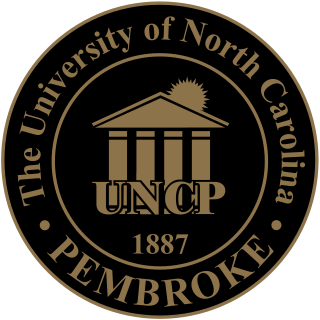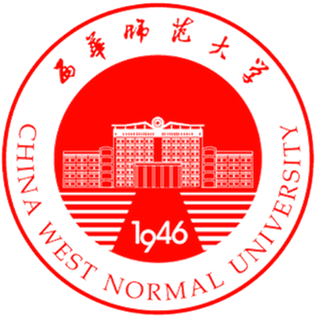Related Research Articles

Ellendale is a city in Dickey County, North Dakota, United States. It is the capital city of Dickey County. The population was 1,125 at the 2020 census. Ellendale was founded in 1882. Ellendale is the home of Trinity Bible College, located on the former campus of the North Dakota State Normal and Industrial School and the Ellendale Opera House currently under renovation.

The University of North Carolina at Pembroke is a public university in Pembroke, North Carolina. UNC Pembroke is a master's level degree-granting university and part of the University of North Carolina system. Its history is intertwined with that of the Lumbee nation.

Minot State University is a public university in Minot, North Dakota. Founded in 1913 as a normal school, Minot State University is the third-largest university in North Dakota, offering undergraduate and graduate degree programs.

A normal school or normal college is an institution created to train teachers by educating them in the norms of pedagogy and curriculum. In the 19th century in the United States, instruction in normal schools was at the high school level, turning out primary school teachers. Many such schools are now called teacher training colleges or teachers' colleges, but in Mexico continue to be called normal schools, with student-teachers being known as normalistas. Many schools currently require a high school diploma for entry, and may be part of a comprehensive university. Normal schools in the United States, Canada and Argentina trained teachers for primary schools, while in Europe, the equivalent colleges typically educated teachers for primary schools and later extended their curricula to also cover secondary schools.

Minnesota State University Moorhead (MSUM) is a public university in Moorhead, Minnesota. The school has an enrollment of 7,534 students in 2019 and 266 full-time faculty members. MSUM is a part of the Minnesota State Colleges and Universities system. MSUM is located on the western border of Minnesota on the Red River of the North in Moorhead; across the river lies Fargo, North Dakota.
Dickinson State University (DSU) is a public university in Dickinson, North Dakota. It is part of the North Dakota University System. It was founded in 1918 as Dickinson State Normal School and granted full university status in 1987.

Storer College was a historically black college in Harpers Ferry, West Virginia, that operated from 1867 to 1955. A national icon for Black Americans, in the town where the 'end of American slavery began', as Frederick Douglass famously put it, it was a unique institution whose focus changed several times. There is no one category of college into which it fits neatly. Sometimes white students studied alongside Black students, which at the time was prohibited by law at state-supported schools in West Virginia and the other Southern states, and sometimes in the North.

Dakota State University (DSU) is a public university in Madison, South Dakota. The school was founded in 1881 as a normal school, or teacher training school. Education is still the university's heritage mission, but a signature mission of technology was added by the state legislature in 1984 to specialize in "programs in computer management, computer information systems, and other related undergraduate and graduate programs."

Northern State University (NSU) is a public university in Aberdeen, South Dakota. NSU is governed by the South Dakota Board of Regents and offers 45 bachelor's degrees, 53 minors, six associate degrees, 16 pre-professional programs, 23 certificates and 10 graduate degrees.

Black Hills State University (BHSU) is a public university in Spearfish, South Dakota. Close to 4,000 students attend classes at its 123-acre (50 ha) campus in Spearfish, with a satellite campus in Rapid City that is shared with South Dakota State University, and through distance offerings. Enrollment comes from 64 out of 66 counties in South Dakota, 43 states, and 29 countries. BHSU is governed by the South Dakota Board of Regents.
Trinity Bible College and Graduate School (TBCGS) is a private bible college and graduate school in Ellendale, North Dakota. It is affiliated with the Assemblies of God USA.
Lowell State College was a public college in Lowell, Massachusetts. It was established in 1959 and is the precursor to the University of Massachusetts Lowell. The founding of this new state school was the culmination of decades of institutional growth that began in 1894 with the establishment of Lowell Normal School, continued through the transition to the four-year Lowell Teachers College in 1932, and concluded in 1959 with the founding of Lowell State College. From 1959 to 1975, Lowell State College served the region's need for comprehensive public higher education. It was not superseded in this role until the merging of Lowell State College and Lowell Textile Institute into one new organization—University of Lowell and then the University of Massachusetts Lowell in 1991. The Lowell State College campus continues to serve as the core of what is now known as the University of Massachusetts Lowell's South Campus. The final enrollment at Lowell State College was 2,353 students with 1,877 of them undergraduates and 476 of them being postgraduates.
A comprehensive regional university today, the University of North Alabama traces its beginnings to the first half of the 19th century, when the Methodist Episcopal Church sought to bring learning and culture to an obscure mountain in Alabama.

China West Normal University is a provincial public normal university featuring teachers education and training located in Nanchong, Sichuan, China.

The University of North Texas College of Music, based in Denton, is a comprehensive music school among the largest enrollment of any music institution accredited by the National Association of Schools of Music. It developed the first jazz studies program in the nation, and it remains one of the top schools for jazz. As one of thirteen colleges and schools at the University of North Texas, it has been among the largest music institutions of higher learning in North America since the 1940s. North Texas has been a member of the National Association of Schools of Music for 84 years. Since the 1970s, approximately one-third of all North Texas music students have been enrolled at the graduate level. Music at North Texas dates back to the founding of the university in 1890 when Eliza Jane McKissack, its founding director, structured it as a conservatory.
Orlo Allen Sundre is a former American football coach. He served as the head football coach at Ellendale State Teachers—later known as the North Dakota State Normal and Industrial School—in Ellendale, North Dakota from 1961 to 1962 and Dickinson State College—now known as Dickinson State University–in Dickinson, North Dakota from 1966 to 1967, compiling a career college football coaching record of 4–27.
Eastern Michigan University was founded in 1849 by the state of Michigan, and opened in 1853 as Michigan State Normal School. Michigan State Normal School was the first in Michigan and the first normal school created outside the original 13 colonies.

The history of East Texas State Teachers College (ETSTC) comprises the history of the university now known as Texas A&M University–Commerce from its renaming as East Texas State Teachers College in 1923 to its renaming as East Texas State College in 1957. During this era, ETSTC was led by four different presidents, two of whom served for more than a decade. The ETSTC period was marked by increasing recognition, notably through obtaining membership in the Southern Association of Colleges and Schools (SACS) in 1925, as well as marked growth in its faculty, student enrollment, and physical plant. ETSTC grew from 65 faculty in 1925 to 132 in 1957, from approximately 1,000 students in 1925 to over 3,000 in 1958–59, and from six buildings valued at roughly $500,000 in the early 1920s to a physical plant valued at over $4 million in 1949.
Ellendale Public School District No. 40 is a school district with a single K-12 school, Ellendale Public School, in Ellendale, North Dakota. One division is Ellendale High School (EHS).
Elmer Olaf Thompson (1890-1983) was a photographer and inventor born in North Dakota.
References
- Black, R.M., ed. A History of Dickey County, North Dakota. (Ellendale, ND: Dickey County Historical Society. 1930). 63-68. https://archive.org/details/HistoryOfDickeyCounty1930
- Coleman Memorial Museum, Normal and industrial School Collection, https://archive.org/search.php?query=creator%3A%22Coleman+Museum%22
- Ellendale, North Dakota. 125th Anniversary, “Colleges” (Ellendale: J and M Printing, 2007), 114-118.
- Goddard, Connie. “A ‘Howling Success’: Ellendale’s State Normal and Industrial School, 1899-1929. North Dakota History: Journal of the Northern Plains 87, no.1(Fall 2022): 18-34.
- Robinson, Elwyn B. (1966). History of North Dakota . Lincoln: University of Nebraska Press. pp. 314–315.